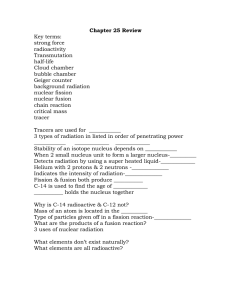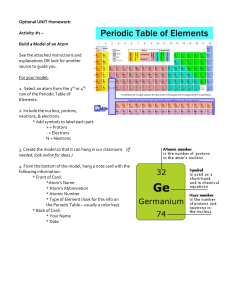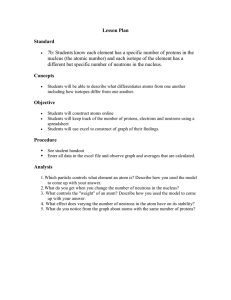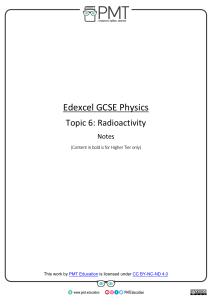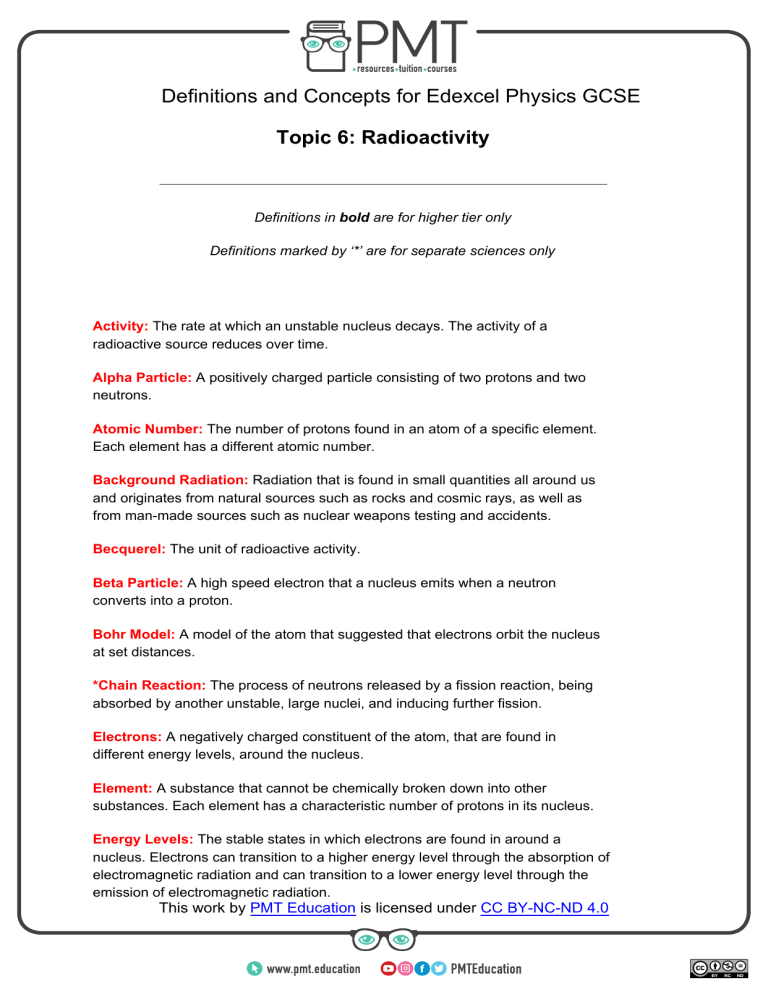
Definitions and Concepts for Edexcel Physics GCSE Topic 6: Radioactivity Definitions in bold are for higher tier only Definitions marked by ‘*’ are for separate sciences only Activity: The rate at which an unstable nucleus decays. The activity of a radioactive source reduces over time. Alpha Particle: A positively charged particle consisting of two protons and two neutrons. Atomic Number: The number of protons found in an atom of a specific element. Each element has a different atomic number. Background Radiation: Radiation that is found in small quantities all around us and originates from natural sources such as rocks and cosmic rays, as well as from man-made sources such as nuclear weapons testing and accidents. Becquerel: The unit of radioactive activity. Beta Particle: A high speed electron that a nucleus emits when a neutron converts into a proton. Bohr Model: A model of the atom that suggested that electrons orbit the nucleus at set distances. *Chain Reaction: The process of neutrons released by a fission reaction, being absorbed by another unstable, large nuclei, and inducing further fission. Electrons: A negatively charged constituent of the atom, that are found in different energy levels, around the nucleus. Element: A substance that cannot be chemically broken down into other substances. Each element has a characteristic number of protons in its nucleus. Energy Levels: The stable states in which electrons are found in around a nucleus. Electrons can transition to a higher energy level through the absorption of electromagnetic radiation and can transition to a lower energy level through the emission of electromagnetic radiation. https://bit.ly/pmt-edu-cc This work by PMT Education is licensed under https://bit.ly/pmt-cc CC BY-NC-ND 4.0 https://bit.ly/pmt-edu https://bit.ly/pmt-cc https://bit.ly/pmt-cc *Fission Products: Fission produces two smaller nuclei, two or three neutrons and gamma rays. All these products are released with kinetic energy. Gamma Ray: Electromagnetic radiation emitted from a nucleus. Geiger-Muller Tube: A device used to detect ionising radiation. Half-Life: The time it takes for the number of unstable nuclei of an isotope in a sample to halve, or the time it takes for the initial count rate of a sample of the isotope to halve. Ions: Atoms with a resultant charge due to the loss or gain of electrons. Irradiation: The process of an object being exposed to nuclear radiation. The object doesn’t become radioactive. Isotopes: Atoms with the same number of protons but different numbers of neutrons. The atomic number is the same, but the mass number is different. Mass Number: The number of protons and neutrons in an atom. Negative Ions: Atoms that gained electrons and so have a resultant negative charge. Neutrons: A neutrally charged constituent of the nucleus. *Nuclear Fission: The splitting of a large and unstable nucleus into two smaller and more stable nuclei to produce energy. This is the method currently used in nuclear power stations. *Nuclear Fusion: The joining of two small, light nuclei to form a larger, heavier one and release energy. It cannot happen at low pressures and temperatures since in these conditions the electrostatic repulsion of protons in the nucleus cannot be overcome. Nucleus: The positively charged centre of an atom, containing protons and neutrons. *PET Scanner: A medical imaging device that uses radioactive tracers and detectors to form internal body images. Plum Pudding Model: An old model of the atom that represented the atom as a ball of positive charge, with negative charges distributed throughout it. Positive Ions: Atoms that have lost electrons and so have a resultant positive charge. https://bit.ly/pmt-edu https://bit.ly/pmt-cc https://bit.ly/pmt-cc Protons: A positively charged constituent of the nucleus. Radioactive Contamination: The unwanted presence of radioactive atoms on other materials. It is hazardous due to the decay of the contaminating atoms. Radioactive Decay: The random process involving unstable nuclei emitting radiation to become more stable. Random Nature of Radioactive Decay: You cannot predict which nuclei in a radioactive sample will decay next, or when the next decay will occur - it is a random process. https://bit.ly/pmt-edu https://bit.ly/pmt-cc https://bit.ly/pmt-cc

